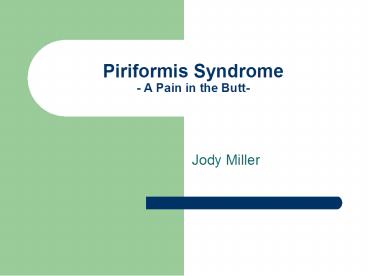Piriformis Syndrome A Pain in the Butt - PowerPoint PPT Presentation
1 / 22
Title:
Piriformis Syndrome A Pain in the Butt
Description:
Despite the description, it has remained a controversial ... Pain in the labia majora in women and pain the the scrotum in men. Pain when getting up from bed ... – PowerPoint PPT presentation
Number of Views:2269
Avg rating:1.0/5.0
Title: Piriformis Syndrome A Pain in the Butt
1
Piriformis Syndrome- A Pain in the Butt-
- Jody Miller
2
The Sciatic Nerve
3
What Is Piriformis Syndrome?
- Piriformis Syndrome was first described in 1928
as a periarthritis of the anterior sacroiliac
joint - Piriformis Syndrome refers to irritation of the
sciatic nerve as it passes through the piriformis
muscle - Despite the description, it has remained a
controversial diagnosis. With some in the
medical community claiming that the condition
does not even exist.
4
What is Sciatica?
- Radiculopathy or compression of a nerve root as
it exits the spine - Signs and symptoms are closely related, but the
source of the irritation differs
5
The Piriformis Muscle
- Origin
- Pelvic surface of the sacrum between (and lateral
to) the first through fourth pelvic sacral
foramina - Margin of the greater sciatic foramen
- Pelvic surface of the sacrotuberous ligament
- Insertion
- Superior border of the Greater Trochanter of the
femur - Innervation
- Sacral plexus (L5, S1, S2)
6
Anatomy
- There are multiple variations of the muscle
structure - Shape is variable
- In the majority of cadaver dissections, the
sciatic nerve is found to run underneath the
piriformis fibers - Occasionally the nerve runs between the fibers of
a bifid muscle
7
(No Transcript)
8
Actions
- External rotation of the hip
- Abduction of the hip when the hip is flexed
- Some slight extension of the hip
- Example
- While balancing on the left foot, the piriformis
moves the right leg directly sideways away from
the body and rotates the right leg so that the
toes are pointing towards the ceiling
9
(No Transcript)
10
Symptoms of Piriformis Syndrome
- Piriformis Syndrome is characterized by pain and
instability - The location of the pain can be imprecise, but it
is often present in the hip, coccyx, buttocks,
groin, or distal part of the leg - The symptoms most often reported are pain during
running and walking
11
Frequency
- In the US the female-to-male ratio is 61
- In about 15 of the population, the sciatic
nerve runs through the piriformis muscle, rather
than below it - One author estimated that the incidence of
piriformis syndrome in patients with sciatica is
6
12
Causes of Piriformis Syndrome
- Trauma to the buttocks or gluteal region is the
most common - Skiers, truck drivers, tennis players, and long
distance bikers and runners are at high risk - Morton foot may predispose you to piriformis
syndrome - Anatomic variations of the divisions of the
sciatic nerve above, below, and through the
piriformis may also be a factor
13
Short or Long
- Commonly when the syndrome is present, the muscle
is considered to be short - Kendall reports that the symptoms of the syndrome
can also be found in patients who have a
lengthened piriformis muscle - The length of the muscle needs to be carefully
examined before intervention and treatment begin
14
How Do You Get A Long Piriformis?
- In a faulty position where the leg is in
adduction and internal rotation with an
anteriorly tilted pelvis - This position puts the piriformis in a stretched
position - The mechanism of this position thrusts the
piriformis muscle and the sciatic nerve into
close contact
15
Diagnosing Piriformis Syndrome
- It is a diagnosis of exclusion
- The only true positive sign is considered to be
tenderness over the gluteal region - Pain can be reproduced with the maximum
elongation of the muscle - Weakness can be found with resistance to external
rotation and abduction of the hip
16
Red Flags
- Patients with Piriformis Syndrome are likely to
have the following symptomatic history - Chronic pain in the buttocks
- Pain with walking and running, climbing stairs,
and squats - Pain with bowel movements
- Pain in the labia majora in women and pain the
the scrotum in men - Pain when getting up from bed
- Pain with hip adduction and internal rotation
- Intolerance to sitting
17
Stretching the Piriformis
- Have the patient lie on his/her back
- Use the leg on the affected side and cross the
patients body - Knee to opposite Ear
- Examiner can apply pressure in the similar
direction to increase the stretch
18
? Superior View
Inferior View ?
19
More stretching
- Place the right knee on the ground roughly in
line with your left shoulder - The right foot should be just in front of the
left knee - Press your hips towards the ground so that your
bodyweight is on your right leg - As you move down the right knee comes closer to
the left shoulder - You should feel a gentle pull deep in the right
hip/buttocks
20
- If the muscle is tight, pain and a stretching
sensation will be felt in the gluteal region - If the muscle is irritating the sciatic nerve,
pain may be present and will radiate through the
buttocks and possibly down the leg
21
Other Treatments
- Moist heat and/or ultrasound prior to stretching
- Muscle Energy Techniques
- Myofascial Release Techniques
- Stretch other muscles
- Iliopsoas, TFL, hamstrings, gluts
- Exercises to strengthen the piriformis
- NSAIDs
- Manual Manipulations
- Surgical intervention
- Release of the piriformis tendon
- Last resort treatment
22
Prevention
- Recurrence of pain in the piriformis muscle can
be prevented by continuing the stretching
exercises and by avoiding known risks factors































